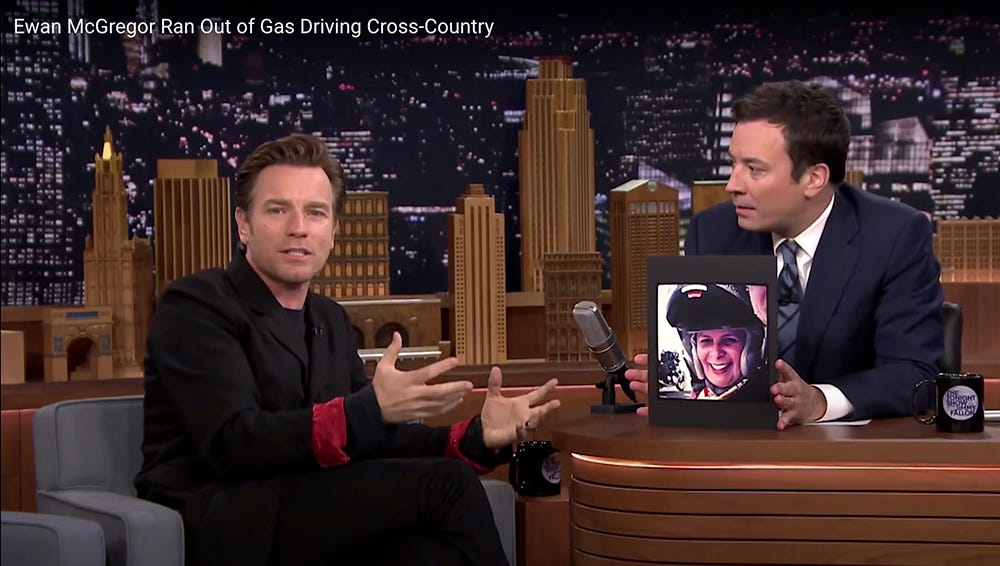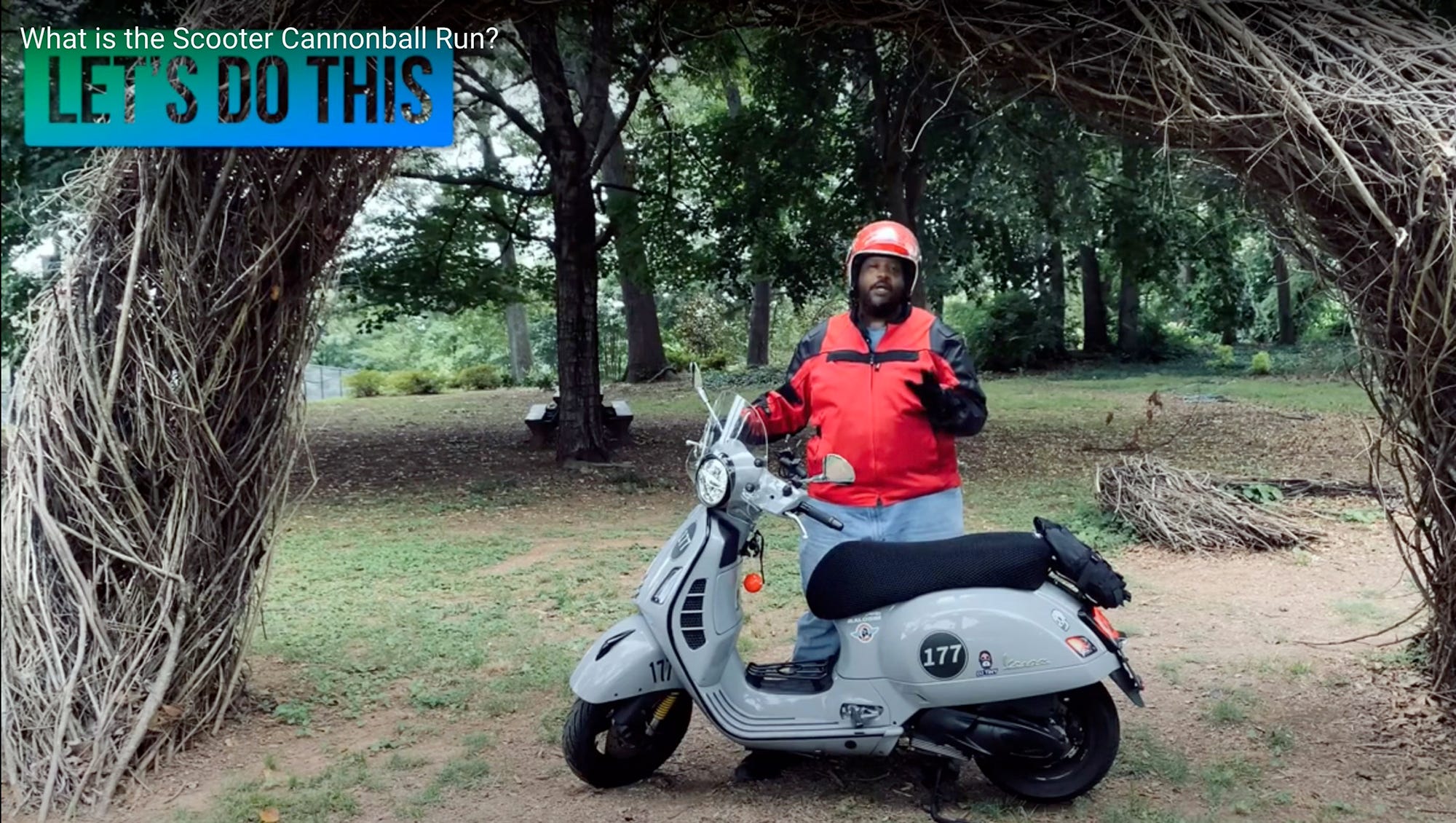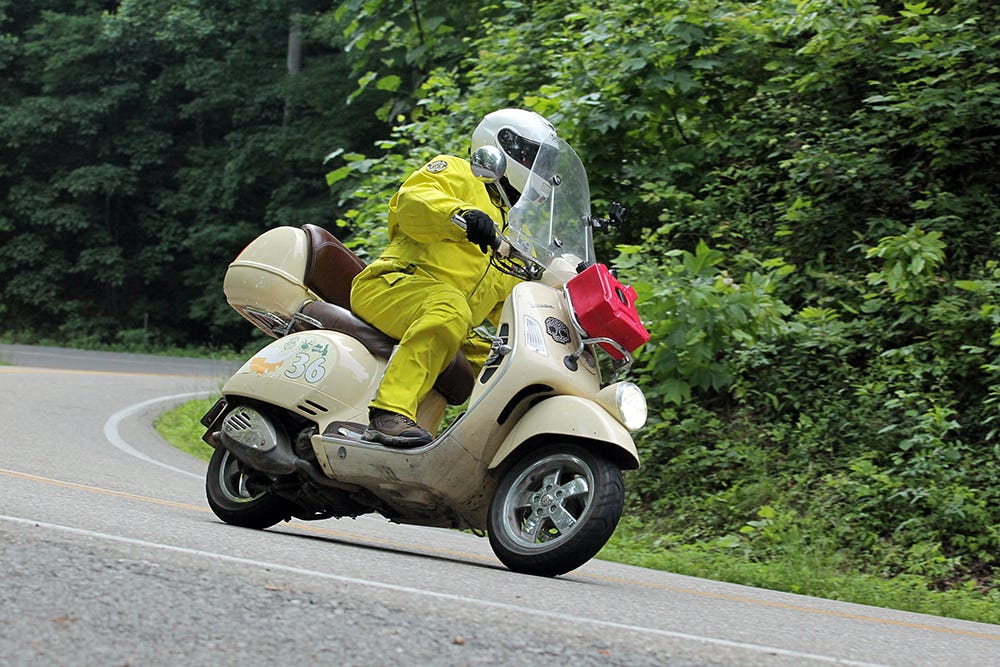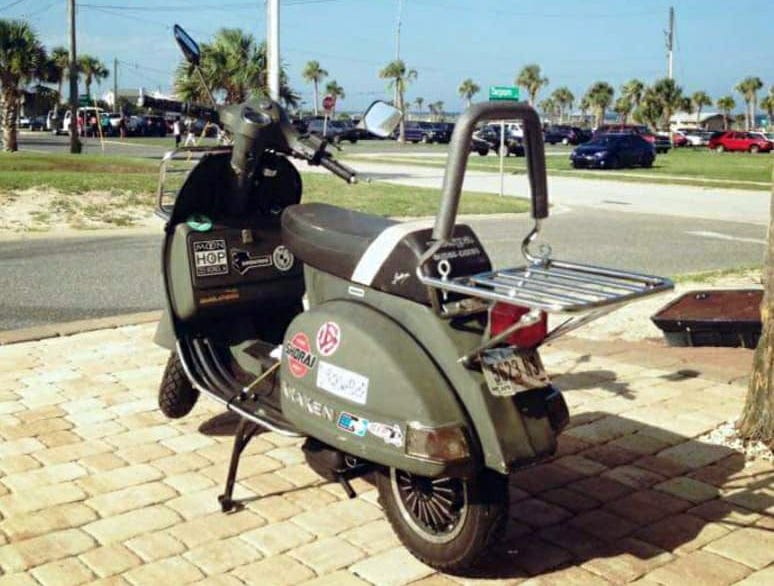Illustrations by Veronica Bravo, USA Today
It may sound crazy, but on July 12 more than 90 riders aboard motorized scooters – yes, scooters, some with engines smaller than your average lawnmower – will roll out of a hotel parking lot in Bar Harbor, Maine, and begin a grueling 10-day, 4,500-mile ride to Eureka, California.
They'll be riding, and sometimes suffering, in the ninth Scooter Cannonball, a scooter-only, rally-type event that'll offer relentless heat, cold rain and high winds. They’ll be fighting off exhaustion after 10 to 14 hours a day in the saddle.
Riders will travel an average of 447 miles per day. Their longest day will be 527 miles.
They’ll use paved secondary roads and gravel paths, and some will ride across mountain passes 10,000 feet high, which will sap engine power and cut speeds to 10 or 15 mph.
"It's kind of insane, when you think about it," says Cletha Vaillancourt, a first-time rider this year. She and her husband will take "150cc scooters, pretty small scooters, 4,500 miles across the country. That's a pretty epic adventure."
It's not a race. It's a test of endurance and navigational skills where checkpoints are documented and points awarded "based on miles completed and the ability to maintain the standard pace," organizers say.
It may sound crazy, but the Cannonball is a challenging ride that draws a unique group of people. A few are relatively new to the scooter scene; others are experienced riders who've motorcycled to places most of us only dream about.
Some have competed in other long-distance events, including Iron Butt Association motorcycle rides, which range from 1,000 miles in 24 hours to its signature rally of more than 11,000 miles in 11 days.
But most are scooter enthusiasts. The Cannonball is a biennial event that was originally scheduled for 2020 but was pushed to 2021 because of the pandemic. Participants will ride machines better suited for around-town excursions or afternoon country jaunts, not thousands of miles of extended punishment.
In 2018 on Day 5, I was cursing and I wasn't sure if I was going to make it. I was like, 'why am I doing this? I have nothing to prove.' These were the things coming out of my mouth. And I was like, 'I will never do this again.'
The largest scooters of this year's event include Vespas with 278 cubic centimeter engines, with 24 horsepower or less. One of the smallest is a 50cc Honda Ruckus, with 4.4 horsepower, according to webbikeworld.
By comparison, a familiar long-distance touring motorcycle like the Harley-Davidson Electra Glide has 92 horsepower and weighs 820 pounds. European and Japanese sport-touring bikes have even more power.
But Cannonballers won't just ride. They’ll pore over maps and road books and tap navigational GPS units to stay on course and calculate the best routes for bonus points.
They’ll postpone sleep to maintain their own machines, including swapping out tires, drive belts and other components after dark, clinking wrenches under headlamps in front of motel rooms.
The (Cannonball) odds are really against you. These are little tiny, urban motorcycles, they're not meant to go across the country. You've got to have a little bit of mechanical ability just to keep these things running when you're doing 500 miles a day.
A few will have family members driving pickup trucks as support vehicles, or will chip in with other riders for a truck carrying supplies. Others will pile everything on their own scooters.
Who are the folks in this year's Cannonball?
The rally attracts men and women riders who want to win, or just finish for the memories and bragging rights.
Some do it once and never come back. Others can't wait to try again.
This year, 76 of the 91 riders are "rookies," those who haven't been here before. Eight are back for a second attempt. And this time, more women have signed up than in any other year.
One of the best things is the camaraderie. You're sizing up everybody on the first day. After the second or third day, everybody's just buddies, trying to make things happen.
"I would say the vast majority haven't gone on a ride like this," says #79, Dave Bednarski, 38, from Allentown, Pennsylvania. He’s an organizer and event participant who’s known as Feb31st. This is his sixth Cannonball.
"Our typical participant may have done a two-day rally or meetup," Bednarski says. "A lot of them have done some touring on motorcycles, or adventure rides, where they're not necessarily held to a strict schedule. This is a little bit of a twist for them."
Dropout rates from mechanical or human issues range from 10% in 2014 to 27% in the "very challenging route" of 2018.
"I'm pretty optimistic about 2021 being under 20%," Bednarski says.

Everyone asks: Why do they do it?
Madeleine Velázquez (Missrider) #26
"It's the challenge of a smaller bike and the technicalities involved," says Velázquez, a computer science teacher from Worcester, Massachusetts, and one of the event's most widely traveled riders.
"I'm 64 years old, a cancer survivor and very proud that I can still ride a motorcycle for extreme distances," she says. "I enjoy inspiring the younger generation, especially women."
Her rider name, as listed on the Cannonball website, is Missrider. She's taken motorcycles across the contiguous U.S., up into Alaska, down to the Panama Canal and across Africa. This is her first Cannonball, and she's doing it on a Honda Super Cub 125, a scooter with about 10 horsepower.
Velázquez has been riding for about 40 years. "The most rewarding part of an adventure rider is being one with the machine," she says. "I also love meeting folks on the road. Many are very welcoming and have opened their homes to help a sole female rider."
Women – and men – approach her at gas stations and ask about her bikes and what it's like to ride. "I tell them, 'Don't be scared, take on the sport, be your own person, but just try it. And if you don't like it, then don't do it,'" she says.
"But it's a wonderful experience. It gives you freedom and you can do lots of things," Velázquez says.

While on her motorcycle in 2014, Velázquez stopped on a Utah highway to help a man in a British sports car that was out of gas. He turned out to be "Star Wars" actor Ewan McGregor, who's also ridden motorcycles with Charley Boorman around the world in "Long Way Round," "Long Way Down" and "Long Way Up."
"I didn't know who he was," Velázquez says, even after McGregor identified himself as an actor. It was only after he mentioned the Long Way rides that she realized who she had stopped for.
Even so, "I was more engaged in solving the petrol problem so we could continue our travels safely," she says.
McGregor talked about the encounter on "The Tonight Show" with Jimmy Fallon. He and Velázquez have stayed in touch.
Cletha Vaillancourt (Queenb) #131
"Cause it's crazy," says Vaillancourt, 64, a retired securities attorney in Tupelo, Mississippi. She's known as Queenb, and she's riding with her husband, Eric (EricV), in their first Cannonball, both on Honda ATV 150 scooters.
They've done a lot of long-distance motorcycle rides together and Vaillancourt completed the epic Iron Butt Rally solo in 2011 – more than 11,000 miles in 48 states in 11 days.
"For me, it's the adventure and the challenge," she says.
During her Iron Butt ride, she found, "It changes you. You find out what you're made of and what you can overcome. And boy, I know when I did Iron I spent a lot of time talking to God and angels. You're really alone for so much of the time."
Eric Semple (VespaChef) #8
“Why? My wife asked me the same question,” says Semple, 65, of Calgary, Alberta, and the sole rider from Canada. Pandemic restrictions on travel prevented a few others from competing.
Semple is known as VespaChef because of his culinary background and this is his first Cannonball. He's on a 2011 Vespa GTV 300.
“I use one word, I call it ‘adventure,’” Semple says. He’s a Vespa aficionado who stumbled across the Cannonball while researching scooters a few years ago.
“I thought, ‘This is spectacular,’” Semple says. “It's what a scooter is all about, riding on secondary roads and seeing the countryside. Riding 10 hours a day is a bit of a challenge, but you can prepare yourself for it. It’s really exciting, an adventure.”
It's what a scooter is all about, riding on secondary roads and seeing the countryside.
He rode motorbikes as a kid but stopped when he and his wife had children. He started riding scooters again "a little over a year and a half ago," he says.
"One of the kickers for this was I lost my mom and dad in 2015 and 2016," Semple says. "I spent my dad's final year with him and he told me, 'You should do the things you want to do. Don't set things aside, life is too short.'"

Tim Jackson (DJ TINY) #177
"I used to be a streetbike rider, on crotch rockets, but I got away from them," says Jackson, 44, a touring disc jockey from Atlanta who goes by DJ TINY. "They can be dangerous. As my wife Serena said, 'the next motorcycle will come with divorce papers.'"
But during a recent trip to Mexico he rented a scooter for the day and fell in love with it. "So I purchased a Vespa and I've been riding around Atlanta during the pandemic," Jackson says. He discovered the Cannonball and decided to join. He'll be on a 2020 Vespa GTS 300 HPE and is documenting his ride online.
"Atlanta has some great backcountry. I just go out and pick a direction and GPS my way back home," Jackson says. "I'm averaging about 300 miles a day on these rides."
He's put about 6,000 miles on the Vespa since buying it eight months ago.
Winning this event requires 10 days of perfect navigation, fuel planning, and no unplanned mechanical breakdowns.
"I love it. It's like riding on a couch, it's so comfortable," says Jackson, who used to play football. "I'm about 6 ft., 5 in., and weigh about 330 pounds, so I needed something for my size. It's perfect."
The most difficult part of the Cannonball will be the unknown, maybe the navigation, Jackson says. "I think the riding will take care of itself. I've been doing enough of these 300 mile rides that throwing on a couple of extra 100 miles won't be a problem."
His dealer, Vespa Marietta in Georgia, "is giving me a crash course on the things I might have to work on," Jackson says. "Things like how to change oil, tires and belts."
And his wife will drive his support vehicle.

Brook Dain (ADVscooter) #36
“That’s a hard question,” says Dain, 52, who lives in San Jose, California, and is a creative services manager in city government. His rider name is ADVscooter, and he was in the 2018 Cannonball. Now he's back for more, aboard a 2020 Vespa GTS 300ie.
"Why I'm doing it again, I don't know," Dain says. "After the first one, I said, 'That was really dumb. I'm never going to do that again.'"
Like a few others, he's documenting his participation in a series of short, precise Youtube videos. A veteran rider, he's taken scooters through Pakistan, India, Egypt and elsewhere.
The Cannonball “is just about the silliest thing I can think of,” Dain says. “But life is short and I’m going to do the crazy things I can do while I’m young enough. There’ll be lots of years to brag about them later."
For this year's ride, he meticulously upgraded a 2007 Vespa, did a test ride and – in a jaw-dropping moment of bad luck – "one of the fuel lines popped. And I had an engine fire," he says.
He scrambled to prepare a replacement. "I'm one of these crazies, I've got like five, six scooters," he says. "I bought a 2020 Vespa last year and I quickly prepped that to be my Cannonball bike.
"That's going to be a lot more reliable than a nearly 20-year-old bike but it lacks some of the romance of having built the bike yourself," Dain says.
Linda Hurley (LindaHurley) #24
"It's the adventure, and yes, it's something different," says Hurley, 57, a technical support manager for a medical device company. She lives in Aliso Viejo, California, and her rider name is LindaHurley.
"I'm definitely new to this event," Hurley says. "I don't know any of the people who are riding or organizing but it'll be fun meeting everybody.
"I was kind of becoming a couch potato about 12-13 years ago and knew I had to do something," Hurley says. She saw an episode of "Orange County Choppers" that involved scooters and decided to get one.
"I bought a little Yamaha Vino 125 and I loved it," she says. "About six months later I bought a larger scooter, a Yamaha Majesty 400." A Yamaha FJR motorcycle was added later.
Hurley participated in multiday motorcycling events over the past 10 years. "I still really like scooters and I saw this event so I bought a 2018 Yamaha SMAX just to ride in it. I'm looking to finish, but I'd really like to win.
"But the Cannonball is a different thing for me," Hurley says. "A different format, over 10 days straight, it's grueling."
Seth Hershey (sethhershey) #21
"I'd say it's twofold," says Hershey, 39, of Cincinnati. He's known as sethhershey and he's a certified Vespa mechanic and the owner of Metro Scooter in Cincinnati. He'll ride a 2019 Vespa Sprint 150.
"First, I love traveling and I want to see what I'm made of," Hershey says. "Second, we get a lot of people who ask 'what can you do on a scooter?' Well, I do a lot. And I'm going to be able to say that I've done it."
His father rode Harleys, but Hershey discovered scooters "when I was like 13 or 14. I found out there was more than just Harley-Davidsons, suddenly there was this red Italian sexy sport bike in Popular Mechanics and I was like 'What? They come shaped like that, too?'"
"I'm not competitive," Hershey says. "I'll be happy just to finish. I want to get as many points as I can via the bonus checkpoints."
The Cannonball is "the romance of riding a red Vespa across the country," Hershey says. "The romance of a tour down Main Street America is how I describe it."
The hardest thing will be camping in the evening and looking on my phone at photos I took with my girls. That's going to be the hard part. That's going to be like, 'Oh, I can't wait to be hanging out with them again.'
But while he's looking forward to the Cannonball challenge, "the hardest thing will be camping in the evening and looking on my phone at photos I took with my girls."
"That's going to be the hard part," Hershey says. "That's going to be like, 'Oh, I can't wait to be hanging out with them again.'"
Danielle Tarner (SassyPony) #137
"I always wanted to go coast to coast on two wheels," says Tarner, 45, of Manhattan, Kansas, who's known as SassyPony and is an instructor at Kansas State University. This is her first Cannonball and, like Velázquez, she'll ride a Honda Super Cub 125.
After forgoing bicycling following knee surgery, "I started looking at scooters and with the pandemic I got squirrelly and wanted to get out there so I bought a scooter," she says. While researching cross country travel, "this event popped up and I thought, 'Whoa, this looks pretty epic. I should try this.'"
She's looking to "finish the event and enjoy the ride."
"A girlfriend got me a T-shirt and it's a fluorescent green shirt with a black scooter and lettering that says, 'Life's a hoot when you ride a scoot,'" Tarner says. "It pretty much sums up my mantra for for this adventure."
I'm doing this because of the challenge on a smaller bike and the technicalities involved. I enjoy inspiring the younger generation, especially women.
Remember: This is not a race
The Cannonball began in 2004. It started as "a little bit more than a cross-country road trip on vintage scooters,” Bednarski says.
As a Cannonball veteran, he's a source of knowledge and inspiration for other riders. And while it usually takes three volunteers to organize a Cannonball, "this year is a little different," he says. "It's pretty much myself doing all the advanced organizing. Some of that's just what happened with COVID."
- 'A Scooter Affair' podcast talks with David Bednarski: scooteraffair.com/scooter-cannonball-2021/
The Cannonball is not a race, organizers emphasize. There's no cash prize; winners will get a fist-sized medal this year, Bednarski says. It comes with a ribbon to hang around one's neck and can also be used to open bottles.
"The original event had a scoring system in place but it was really more of an endurance test of the machine and the rider," he says. "It was a matter of getting from one point to another without accumulating points. Today, that's changed."
You understand that this is not a race. The Cannonball does not condone unsafe activities such as excessive speed, reckless vehicle operation, riding impaired, or any other activity that results in riders exceeding their personal limits, endangering other riders or the public.
Instead of riding fast, riders must navigate accurately, minimize mechanical troubles, calculate fuel needs and travel efficiently, the Cannonball website says. They're required to photo-document visits to required checkpoints and are expected to assist other riders having difficulties.
"What keeps drawing me back is this elusive, kind of perfect 10 days of riding that's so hard to do," Bednarski says. "It's traveling to almost 100 different checkpoints with perfect navigation, no wrong turns."
You'll probably pay $3,000 to $5,000 to ride the Cannonball
Rider fellowships often forged in hardship
Part of the Cannonball's attraction is the esprit de corps of scooter pilots, the friendships built in group rides, forum discussions and chance meetings on the road. There are enthusiasts for many types of vehicles, but motorcycles and scooters are special, riders say.
Empathy may play a part. If you're on a bike out in the rain and you see someone else on a bike, you know that person is probably as wet and cold as you are. The riding experience, good or bad, creates a bond.
For the Cannonball, organizers chose scooters "a little because of the absurdity of it," Bednarski says.
I think there's an even stronger camaraderie with the scooter population than with motorcycles.
"There's a very strong community out there," Bednarski says. "The idea of going slowly across the United States on back roads because modern, smaller scooters can't be taken on interstates, embraces constraint.
"The days are long and it's a challenge for the scooter and rider."
"I think there's an even stronger camaraderie with the scooter population than with motorcycles," says Jeff "Robot" Corsaro, service manager at Vespa Motorsport and scooterwest.com in San Diego. Vespa owners study and revere his numerous how-to-work-on-your-Vespa Youtube videos.
"There may be some divide between the vintage scooter crowd and the modern twist-and-go automatic crowd, but it's much more tight-knit," Corsaro says.
Others agree. "I do think of it like a family," Jackson says. "You saw my profile, I'm a big Black guy and in this scooter community I've been accepted with open arms. I don't even notice that I'm the only Black guy there. It's a welcoming community."
Dain says, "One of the best things is the camaraderie. You're sizing up everybody on the first day. After the second or third day, everybody's just buddies, trying to make things happen."
"At night, if somebody's got a scooter problem, you'll see five or six people huddled around the scooter and everybody's an expert on one portion or another. People don't want to see anybody not finish," he says.
Veterans – and rookies – rushed to sign up this year
More than 180 people registered to ride in this year's Cannonball, a 126% increase from the next highest number of 80 registrants in 2012. Social media, rider videos and a couple of documentaries have boosted interest.
"Typically, we see 60% of those who register show up at the starting line," Bednarski told USA TODAY. At the moment, 82 riders say "yes," they'll be on the starting line. Nine riders say "maybe."
"The cross-country aspect, the adventure, is appealing," Bednarski says. "It's a fairly structured event. Riders don't have to do a lot of planning in terms of selecting the route or hotels."
"So it does offer a framework for a cross-country adventure, but ultimately, they still have to sit and ride the ride."
Maintenance, mechanical ability is key
While scooters are usually regarded as around-town vehicles, "the Cannonball is quite the opposite," says Corsaro of Vespa Motorsports. "Several participants in the Cannonball, they just don't make it because they have engine, transmission or tire problems."
"The (Cannonball) odds are really against you," Dain says. "These are little tiny, urban motorcycles, they're not meant to go across the country. You've got to have a little bit of mechanical ability just to keep these things running when you're doing 500 miles a day."
What should riders do?
"Know at least the basics, like how to remove and change a tire – that's more difficult than changing one on an automobile," Corsaro says. "With many of the 10- or 12-inch scooter tires, you may get only 2,000 miles or so out of them. So I see changes maybe two-thirds of the way through the trip."
"And with the newer automatics, the drive belts have a fairly short lifespan. So riders would need the know-how and have the skills and tools to replace a drive belt," he says.
Who's riding the oldest scooter in the Cannonball?
That would be Shawn Johnson, 47, an ER physician from Des Moines, Iowa. He's known as Kraken and he'll be riding a 42-year-old scooter with manual transmission – a classic 1979 Vespa P200, the only two-stroke engine in the entire event. It's his third Cannonball.
Modern scooters have four-stroke engines, which run on gasoline. Older two-stroke engines require gasoline mixed with oil. That costs time.
The Cannonball "is not a race, it's about controlling your pace," Johnson says. "Gas stations are horrible; when you pull into one, you've already lost 20 minutes. And I've got to put oil in my gas tank, so there's another 5 minutes in getting it measured exactly and pouring it in."
Nevertheless, "I'm a vintage enthusiast," says Johnson, who's been working on scooters for 15 years. "I ride old scooters from the '60s and '70s. It gives me the chance to build up the bike, take it apart and replace all the worn parts, ultimately to make it roadworthy, to withstand this whole cross country adventure."

Got any advice for first-time riders?
One of the Cannonball rides started in Alaska
The Scooter Cannonball began in 2004 and was held every two years until 2020, when it was delayed by the coronavirus pandemic. Below are previous Cannonball rides, their start and finish locations, and number of finishers:
Last words: Utter exhaustion to unexpected euphoria
It may sound crazy, but "the Cannonball itself is a whole big animal beast," says Pamela March, 49, of Los Angeles. She's known as gopam and is a film and television entertainment editor who recorded her 2018 ride in a series of videos. She's back to ride, with more videos planned.
She's on her 2007 Vespa GT 200, the same scooter she rode in 2018. She was exhausted at the end but decided she wanted to try again.

"In 2018 I had waterproof leather boots. I didn't have any breathable mesh boots and my feet were roasting. And I got overheated by my feet, I felt like my brain was cooking. And I started making mistakes just because I was so hot," she says.
"On Day 5, I was cursing and I wasn't sure if I was going to make it. I was like, 'Why am I doing this? I have nothing to prove.' These were the things coming out of my mouth. And I was like, 'I will never do this again.' "
"And then on Day 9, I'm like, 'This is so beautiful. I love it. Oh my God, it's been amazing.' And then I was like, well, we'll see if I'll do another one."
I think in our daily lives and society, we can become complacent and lazy. You have to get out there and challenge yourself. It's physical, it's mental. And it's beautiful.
"I think in our daily lives and society, we can become complacent and lazy," March says. "You have to get out there and challenge yourself. It's physical, it's mental. And it's beautiful."
"When you're doing Cannonball, the only thing you can focus on is pretty much doing the thing and surviving. All the daily worries fall away from your life and you are present. You are in the moment."
Still curious? Two documentary films focus on the Cannonball
- "It's Not a Race: The Scooter Cannonball Run" (2010)
- "Slow Ride Home" (2016)
SOURCE USA TODAY research; scootercannonball.com
CONTRIBUTING Veronica Bravo, Janet Loehrke, and Ramon Padilla